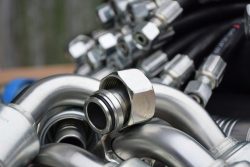The 3 Most Common Types of Hydraulic Hoses

1. Rubber Hydraulic Hoses:
Rubber hydraulic hoses are the most widely used and versatile type of hydraulic hose. Constructed with a rubber inner tube, these hoses are reinforced with multiple layers of braided or spiral high-tensile steel wires or synthetic fibers. The rubber outer cover provides durability and resistance to abrasion, oil, and weather conditions. Rubber hoses are suitable for applications with moderate to high pressures and can withstand a wide temperature range.
Advantages:
– Excellent flexibility, allowing easy installation and maneuverability in tight spaces.
– Superior resistance to impact and vibration, making them suitable for heavy-duty applications.
– Good heat resistance, ensuring stable performance in high-temperature environments.
– Wide availability and cost-effectiveness compared to other hose types.
2. Thermoplastic Hydraulic Hoses:
Thermoplastic hydraulic hoses are constructed with a thermoplastic inner tube, reinforced with one or multiple layers of synthetic fibers or steel wire braids. The thermoplastic material used provides exceptional flexibility and chemical resistance. These hoses are typically lighter and more flexible than rubber hoses, making them ideal for applications that require precise maneuverability and compact design.
Advantages:
– High flexibility, allowing easy routing and reduced installation space requirements.
– Lightweight construction, making them suitable for mobile and portable equipment.
– Excellent resistance to chemicals and UV exposure, ensuring longevity in harsh environments.
– Superior resistance to abrasion and impact, offering extended service life.
– Lower moisture absorption compared to rubber hoses, minimizing issues in damp conditions.
3. PTFE Hydraulic Hoses:
PTFE (polytetrafluoroethylene) hydraulic hoses, also known as Teflon hoses, are designed to handle extreme temperatures, corrosive fluids, and high-pressure applications. These hoses consist of a PTFE inner tube, typically reinforced with stainless steel wire braids or polymer braids. PTFE hoses excel in applications where chemical compatibility, non-reactivity, and temperature resistance are critical.
Advantages:
– Exceptional resistance to a wide range of chemicals, solvents, and corrosive fluids.
– Excellent thermal stability, allowing operation in extreme temperature conditions.
– Low friction properties, offering smooth fluid flow and minimizing pressure drops.
– Suitable for applications requiring cleanliness and non-contamination, such as food processing or pharmaceutical industries.
– Resistant to aging and degradation, ensuring a longer service life.
Choosing the Right Hydraulic Hose:
Selecting the right hydraulic hose for your specific application requires careful consideration of several factors, including operating pressure, temperature range, fluid compatibility, and environmental conditions. Consulting with a reputable hydraulic hose supplier or manufacturer is highly recommended to ensure the hose meets the necessary specifications and safety requirements.
Regular Maintenance and Inspection:
Regardless of the type of hydraulic hose you choose, regular maintenance and inspection are essential for optimal performance and safety. Inspect hoses for signs of wear, damage, leaks, or degradation regularly. Replace any damaged or worn-out hoses promptly to prevent potential system failures and accidents. Additionally, regular cleaning and ensuring proper routing of hoses can extend their service life and minimize potential issues.
Conclusion:
Hydraulic hoses are vital components of hydraulic systems, playing a critical role in fluid transmission and system performance. Understanding the different types of hydraulic hoses – rubber, thermoplastic, and PTFE – allows you to choose the most suitable hose for your specific application. Each type offers unique advantages in terms of durability, flexibility, chemical resistance, and temperature capability. By selecting and maintaining the right hydraulic hose, you can ensure the smooth and efficient operation of your hydraulic system, promoting productivity, safety, and longevity.
Got Questions? Let Us Help!
Categorised in: Hydraulic Hose





